Abstract
At present, various contradictions in most coal-energy cities have become increasingly prominent, which has become a disharmonious factor restricting the optimization and upgrading of coal-energy cities. Since the turn of the century, taking effective improvement and protection measures and promoting the economic transformation of cities reliant on coal as an energy source has been the primary job of departments at all levels in order to secure the sustainable growth of cities. In this paper, the economic transformation and sustainable growth of coal-energy cities are included in the enhanced TOPSIS economic transformation evaluation model based on the proposed entropy weight. This study examines the industrialization of cities that rely on coal energy resources, assesses the industrial efficacy of coal energy using the DEA technique, and proposes a plan for the industrialization of cities that rely on coal energy resources. This paper summarizes the industrial transformation process of coal-energy cities and designs an evaluation method for the industrial economic transformation of coal-energy cities. This paper determines a set of evaluation index systems suitable for the economic transformation of coal-based energy cities; constructs an evaluation model for the economic transformation of improved TOPSIS coal-based energy cities based on entropy weight; and, finally, calculates and analyzes the industrial economic statistics of a city over the years. It is found that, at the economic structure level, the transformation score of driving forces increases from 0.606 to 0.871; at the level of social economic structures, the transition score of the pressure system increases from 0.476 to 0.779, and the transition score of the state system increases from 0.401 to 0.699; at the level of urban construction structures, the transformation score of the pressure system increases from 0.467 to 0.568; and at the level of comprehensive transformation structures, the transformation score affecting the system increases from 0.611 to 0.716. This shows that, in the process of transformation, the driving force of industrial and economic development in coal-energy-based cities is sufficient, while the pressure of social and economic transformation is great. In the process of transformation, we should strengthen infrastructure construction and protect the urban environment.
1. Introduction
Coal-energy cities are cities that range from individual coal mines to cities that integrate production, living, services, and trade. Coal mining is the pillar industry of coal cities, and coal production and output are their main economic function. In addition to providing energy and power for the city’s heating, smelting, and transportation industries, coal also fuels the city’s industrial and domestic electricity through thermal power generation []. The regional distribution of coal energy output value is shown in Figure 1. Many coal-resource-based cities struggle with achieving coordinated development between the economy and the environment because most energy-resource-based cities are heavily dependent on the mining and processing of mineral resources, and the coal energy industry typically has characteristics of high energy consumption and high emissions. This is especially true given China’s ongoing efforts to promote energy conservation and emission reduction. Excessive resource consumption and environmental harm will steadily decline when the industrial structure is upgraded and changed. As a result, the industrial structure must change for resource-based cities’ economies to grow sustainably.
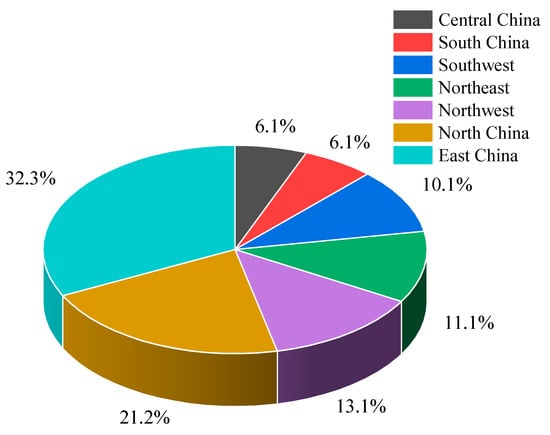
Figure 1.
Regional layout of China’s coal energy industry.
Under the premise of insufficient financial capital accumulation and imperfect social security, social problems and contradictions such as employment, distribution, and residents’ lives in coal-energy cities are gradually highlighted and intensified with the decline of the coal industry, becoming a significant disharmonious factor restricting the stability and development of coal energy-resource-based cities []. Despite their high dependence on resource advantages, some emerging coal-energy cities in Inner Mongolia and western China still need to break through potential development barriers through institutional and institutional changes due to common problems in the industrial structure and social systems of these cities. Coal energy exploitation acts directly on nature, causing serious damage to the environment. In addition, cities lack public awareness of environmental governance and adequate financial investment. Attention has been turned to the poor environmental quality of cities that rely on coal as an energy source []. After years of high-intensity development, resource reserves have been gradually depleted, mining costs have risen sharply, competitiveness has been seriously weakened, and layoffs have increased significantly. The decline of the leading industries inevitably affects the economic and social development of these cities, and some cities in serious situations are already struggling.
Extensive study has been done on the transformation of coal energy-resource-based cities at home and abroad in order to improve the quality of life of locals and increase the sustainable development capability of coal energy-resource-based cities. According to Papyrakis [], the beneficial direct impact of mineral energy on economic growth is outweighed by the detrimental indirect impact. Tonts [] believes that dependence on coal and other energy often makes cities turn to single-use resources, and diversified development is relatively difficult. Using a data envelopment analysis technique, Fang Xingcun et al. [] assessed the economic transformation efficiency of 23 cities in China that are dependent on energy resources and concluded that these cities’ transformation efficiencies are currently low. Xu Yaxuan et al. [] evaluated the performance of the energy environment in the Central Plains Economic Zone based on China’s urban economic green development index, as shown in Figure 2. Blagojević et al. [] defined and assessed the criteria affecting the efficiency of railroad enterprises and proposed a DEA-based approach (i.e., a method based on data development analysis) to assess the efficiency of railroad enterprises in terms of improving competitiveness. Hassanpour [] studied an assessment including 405 Iranian industries involving input and output criteria by DEA combined with the ratio model of Additive Ratio Assessment (ARAS) and the weighing system of a Kendall and Friedman test supported by SPSS software. The results of the study classify Iranian industries with respect to the nominal capacity of industries in certain clusters. Moreover, the current review paves the way for the implementation of energy and material flows in industries. The transition of the low-carbon economy in Jiaozuo City was evaluated using the TOPSIS evaluation model by Wang Xuejun et al. [].
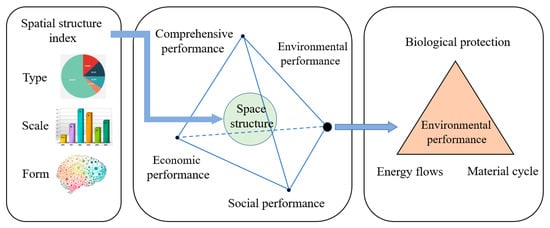
Figure 2.
The relationship between energy mix and environmental performance.
From a comprehensive perspective, the existing studies lack a study that takes an energy-based city as a sample, the energy transition capacity index system has not been formed, and there is less research on the specificity of energy transitions in different types of resource-based cities, not to mention in-depth analyses of the factors influencing energy transition capacity. This paper first analyzes the industrial development process of coal energy-resource-based cities, which is manifested by the depletion of resources and the beginning of coal enterprises’ losses. Then, the industrial efficiency of coal energy is evaluated based on the DEA method, which has the advantage of facilitating the evaluation of the relative efficiency of energy units. Based on this, development strategies for the industrial economy of coal-energy cities are proposed involving energy restructuring, industrial upgrading, and other programs. This paper summarizes the industrial transformation process of coal-energy cities, including the three aspects of environmental assessment, development orientation, and model selection. Then, an evaluation method for the industrial and economic transformation of coal-energy cities, namely AHP hierarchical analysis, is designed. In the study of this paper, a set of evaluation index system suitable for measuring the economic transformation of coal-energy cities is determined. Then, an improved TOPSIS evaluation model for the economic transformation of coal-based energy cities based on entropy weights is established, and the energy economic statistics of a city over a period of time are calculated and analyzed. This study shows that during the transition process, the industrial and ecological economic development of coal-energy-based cities is sufficiently dynamic, while the pressure of social and economic transformation is enormous.
2. Industrial Economic Development Mechanism of Coal Energy-Resource-Based Cities
2.1. Industrial Development Process of Coal Energy-Resource-Based Cities
The benefits of the coal energy industry determine the overall level of the urban economy to a large extent, but the economic benefits brought by coal energy to local areas are lower than their intrinsic values over a long period of time. The income and profits of coal energy enterprises largely depend on the price of coal energy products. The state plans to lower the price of electric coal energy, which accounts for more than half of the total output. There is a considerable outflow of benefits from the coal industry. In addition, after the diversification of energy investment entities, there was vicious competition among private coal mines in various regions. The supply of coal energy was greater than the demand, and the price of coal energy was even lower than the cost price. Many coal energy enterprises suffered losses []. Most of the domestic coal-energy cities are in a period of resource recession or depletion. The industrial pattern supported by the coal energy industry makes it difficult to transform the urban economy, and urban economic growth is slow or even negative, which has become the focus of national assistance and support [].
The coal-energy city’s industry as a whole shows a structural feature that the second, third, and first industries are heavily dependent on the coal energy industry. The industrial structure of coal energy is shown in Figure 3. Coal-based energy cities thrive on coal. Most of them are gradually developed from coal energy production bases. The secondary industry dominated by coal energy accounts for an absolute proportion of the urban economic and industrial structure. The output value and employment of the coal energy industry are in a monopoly position in various industries. The output of coal energy and the market price of coal energy largely determine the rise and fall of cities []. In terms of the construction of the industrial chain, with the coal energy industry as the center, vertically, it is associated with gunpowder, machinery, manufacturing, transportation, and civil engineering industries, and then derives a series of manufacturing industries such as the electricity, metallurgy, and chemical industries, which are raw materials. Horizontally, there are services such as technology, sales, logistics, and transportation. The coal energy is dominated by the export sales of primary products, which is weakly related to the non-energy industries within the city, resulting in a certain degree of labor market segmentation and commodity market segmentation which hinders the city’s industrial economy from generating a positive externality and scale effect and developing in the direction of diversification and integration.
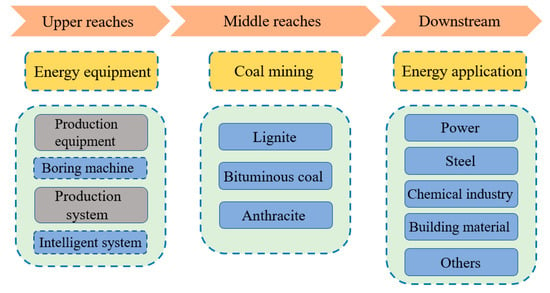
Figure 3.
Coal energy industry production process.
The entropy of the energy industry structure is a significant indicator of its level, indicating the reasonable integrity and capacity for sustainable development of the internal energy industry set up in the area. It is especially appropriate for energy-resource cities with a single structure. The exact formula is as stated in Equation (1):
where Q is the entropy of the energy industry structure, i is the type of energy industry, i = 1, …, n, and Wi is the proportion of i energy industry output value in the total output value. The higher the value is, the more it reflects that the coal energy-resource-based cities maintain balanced development among various industries, and can withstand the risk of fluctuations in the coal energy industry with strong economic growth potential. The single industrial structure and incomplete industrial categories of coal-energy cities have exposed the economy and society to high risks, which is not conducive to the coal-energy cities dealing with the plight of resource depletion in advance and cultivating new economic growth points.
2.2. Efficiency Evaluation of the Coal Energy Industry Based on the DEA Method
Due to the restriction of objective factors such as energy reserves and geographical location, as well as the restriction of subjective factors such as energy industry structure, organizational form, and spatial layout of the energy industry, each coal-based energy city has a certain degree of differentiation and difference in energy industry efficiency and economic development level []. In order to more accurately measure the above differences and provide more effective references for the reform and transformation policies of the energy industry, this section proposes an efficiency evaluation method for the energy industry based on DEA. American operations researchers Charnes A. and Cooper W. created the novel system analysis technique known as “data envelopment analysis” (DEA) based on the idea of “relative efficiency evaluation”. To assess the efficacy of DMUs, it primarily employs linear programming principles and observed effective sample data, multi-index input, and multi-index output.
The DEA method of energy industry efficiency evaluation has the following characteristics:
- (1)
- DEA can deal with the evaluation of the relative efficiency of the energy industry in multi-input decision-making units, especially multi-output decision-making units;
- (2)
- DEA does not have to predetermine the precise input and output functions of the decision-making units, which promotes the relative effectiveness of the evaluation unit.
The study examines the generation of various energy sources and outputs. I organizations or decision-making units use N inputs to get M outcomes. For DMUi, the input vector is I × N vector Xi, and the output vector is I × M vector Yi; then, there are:
The N × I input matrix X and the M × I output matrix Y can be used to represent the energy input and output data of all I cities. As there are multiple energy inputs and outputs, the energy industry decision-making unit (DMU) should be evaluated. All inputs should be combined into a comprehensive input quantity and all outputs into a comprehensive output quantity. Then the input and output should be compared. The weight of each input or output needs to be determined. Set:
The smaller the total energy input I, the greater the total output Q, and the higher the efficiency of the energy industry unit DMU. Therefore, the proportion of total energy input to total energy output serves as a gauge of a device’s efficiency.
Ei is the energy industry efficiency evaluation index of DMUi; each output index’s weight is represented by U, while each energy input index’s weight is represented by V. To find the weight vector that maximizes Ei, for each DMUi, solve the C2R model (P) of DEA to obtain the following maxima:
Change the fractional planning model of the energy industry into the linear planning model of the energy industry:
Then the energy industry model is transformed into:
2.3. Industrial Economy Development Strategy of Coal Energy-Resource-Based Cities
Economic transformation and low-carbon development are two different terms in the emergence, growth, maturity, and decline of coal-energy cities. They interact with one another depending on the functional entity of coal energy-resource-based cities and are born jointly during the development life cycle of such cities. In a way, transformation and development are distinct from one another and related to one another, producing an organic dialectical relationship (as depicted in Figure 4) to support the growth of cities reliant on coal as an energy source.
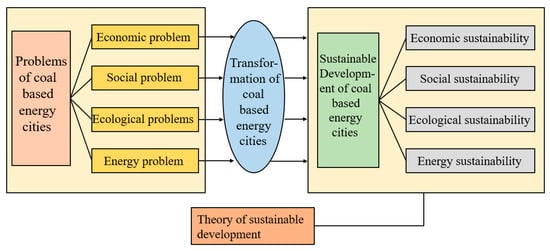
Figure 4.
The relationship between the transformation of coal-based energy cities and sustainable development.
On the one hand, economic transformation serves the dual objective of achieving sustainable economic development of coal energy-resource-based cities and is the sole path to its realization []. The transformation involves economic restructuring, state-owned enterprise reform, regional economic development, labor employment, social security, ecological environment governance, resource exploration and development, resource tax reform, and other related fields, and ultimately achieves the goal of social progress, economic development, ecological environment improvement, and sustainable use of coal energy.
On the other hand, the sustainable development theory of the coal energy-resource-based city economy plays a guiding role in urban transformation []. The central idea of the theory of sustainable development is to encourage the coordinated and shared growth of the economy, society, and ecological environment of coal-energy cities or regions in order to maximize the ecological benefits, economic benefits, social benefits, and other all-encompassing benefits and to realize the objective of sustainable development. The purpose of the transformation of coal energy-resource-based cities is to restructure and ameliorate the issues that exist in these cities in terms of social, economic, ecological, and resource costs, with the ultimate objective being to support the long-term growth of these cities. The transition of cities that rely on coal for energy can be guided by the sustainable development paradigm.
3. Industrial Economic Transformation Plan of Coal Energy-Resource-Based Cities
3.1. Industrial Transformation Process of Coal Energy-Resource-Based Cities
According to the definition of industrial economic transformation of coal energy-resource-based cities, this process aims to help the growth of urban economies break their rigid ties to energy- and coal-resource-based industries and find new, innovative industries to take the place of the coal energy sector, the advantages of which have declined as resources have been depleted. Based on the current situation of coal-based energy cities and the development characteristics of the energy industry, it is necessary to reposition the city’s leading industry and carry out industrial transformation based on its own comparative advantages when studying the industrial transformation of particular coal-based energy cities. The basic industrial transformation path of cities with a coal energy resource base is shown in Figure 5.
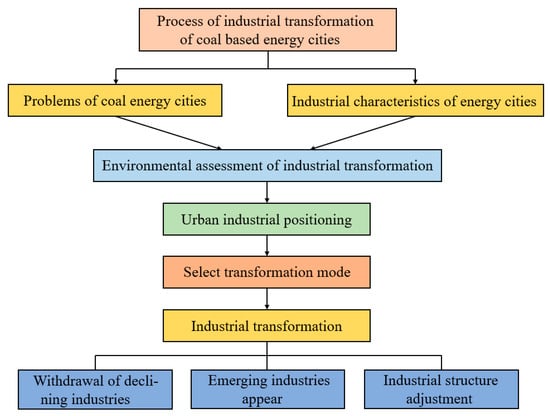
Figure 5.
Flow chart of industrial transformation of coal energy-resource-based cities.
- (1)
- Examine the internal and external context of the industrial economic change of cities dependent on coal as an energy source. Prior to making judgments on the industrial economic transformation of coal energy-resource-based cities, it is important to identify the key influencing elements, which entails analyzing the internal and external environmental factors that limit those decisions. Discover the benefits and drawbacks, and then place the growing industries of coal energy-resource-based cities according to the environmental conditions, choosing the appropriate industrial transformation mode. The industrial transformation environment of coal energy-resource-based cities mainly includes the internal environment and external environment [].
- (2)
- Relocate the industrial growth of cities dependent on coal for energy. The next step is to reorient the industrial growth of coal energy-resource-based cities after weighing the benefits and drawbacks, as well as the strengths and weaknesses of this industrial transformation and development []. When positioning urban emerging industries, it is important to fully take into account the primary functions of the city, the level of urban development, the characteristics of urban development, the stage of economic development, and other factors according to the goals, the environment, and the unique characteristics of a city’s urban industrial development []. Therefore, when repositioning its industrial development, we should combine the advantages of coal-energy cities with the laws of economic development, learn from each other, and develop industries with their own characteristics and advantages.
- (3)
- The choice of industrial transformation mode for coal energy-resource-based cities. There are several choices for the mode of industrial economic transformation of coal energy-resource-based cities. If the coal energy-resource-based cities are still quite rich in resource reserves and have a good degree of mining, they can adopt the advantage extension mode to develop and establish an industrial cluster for deep processing and comprehensive utilization of coal energy. If the coal energy is nearly exhausted and the recoverable resources are insufficient, the alternative industry model can be selected to promote urban economic development []. While rationally developing the existing advantageous industries, seek new industries to complement each other and promote urban development. The green economy transformation model of coal energy-based cities is shown in Figure 6.
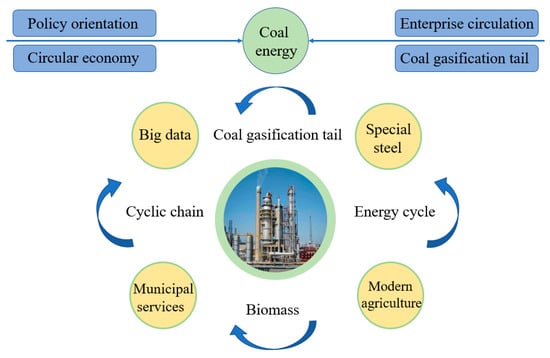 Figure 6. Green economy transformation model of coal energy-based cities.
Figure 6. Green economy transformation model of coal energy-based cities.
3.2. Evaluation Method for Industrial Economic Transformation of Coal-Energy Cities
At home and abroad, multiple studies have been conducted on the selection of evaluation methods for the industrial economic transformation of coal energy-resource-based cities. The main evaluation methods include the AHP method [], factor analysis method [], cluster analysis method [], support vector machine method [], neural network method [], etc. This section integrates the indicators with similar or overlapping information in the indicator system of coal energy-resource-based cities through cluster analysis, so as to highlight the useful information of the indicator system; Following the dimension reduction and correlation elimination of the index system for the industrial economic transformation of coal energy-resource-based cities, the analytic hierarchy process is used to evaluate it. Finally, the factor analysis method is used to deal with the index system, and the primary factors affecting the industrial economic transformation of coal energy-resource-based cities are extracted. The indicators are compared and ordered based on their level and weight, allowing for the organic mixing of global and local data.
The fundamental concept behind using AHP to address the evaluation issue of industrial economic transformation of cities using coal-based energy resources is as follows: A hierarchical and orderly model of the energy industry’s economic hierarchy is created by first hierarchically serializing the problems to be solved, breaking down the energy industry’s structure into its various constituent factors, and then hierarchically clustering and combining the constituent factors based on their mutual influence and subordination relationship. The weight value of the relative importance order of all elements at each level is then calculated by mathematical methods after the relative relevance of each factor at each level in the energy industry model is stated quantitatively in accordance with the judgment of the energy structure. Finally, the combined weight value of the equivalent importance order of the lowest level is obtained through the thorough calculation of the weight value of the relative importance of the factors at all levels of the energy industry structure. This value is used as the basis for the evaluation scheme of the industrial economic transformation of coal energy-resource-based cities. Five steps are involved:
- (1)
- Establish the hierarchical structure model of the coal energy industry. Using AHP to analyze the system, we should first of all organize and level the problems, and construct a hierarchical model of the coal energy industrial structure. The factors involved should be grouped. Each group should be arranged as a hierarchy in the form of the highest level, several related intermediate levels, and the lowest level.
- (2)
- Establish a judgment matrix of coal energy transformation. The information basis of AHP energy transformation evaluation is mainly people’s judgment on the relative importance of various factors at the coal energy level.
- (3)
- A single-level hierarchy sorting the largest eigenvalue’s eigenvector, W, corresponds to the judgment matrix A of coal energy transformation. The ranking weight of the relative importance of the equivalent elements at the same level to a factor at a higher level is what remains after normalization. The term “hierarchical single ranking” refers to this method. When grading hierarchical orders, the judgment matrix’s consistency must be verified, and the procedures are as follows:
- Step 1: Make a consistency indicator calculation.
- Step 2: To find the equivalent average random consistency index R, consult the table.
- Step 3: Determine the consistency ratio and evaluate it.when CR is less than or equal to 0.10, it is thought that the judgment matrix for coal energy transformation is consistent enough; when CR is greater than or equal to 0.1, it is thought that the judgment matrix does not adhere to the consistency standards and has to be amended.
- (4)
- The coal energy sector’s overall ranking. The overall ranking of the coal energy industry level refers to the ranking weight process of establishing the relative importance of all components at a specific level to the overall aim.
- (5)
- Checking for consistency. Calculating a test quantity that is identical to the single ranking is necessary to assess the consistency of the calculation findings for the overall ranking of the coal energy transformation structure hierarchy. Assuming the pairwise comparison of factors related to Aj in Layer B yields the consistency index of single ranking as CI(j), (j = 1, …, m), and the corresponding average random consistency index as RI(j), CI(j), RI(j) has been obtained in the single ranking of layers, then the random consistency ratio of the overall ranking in Layer B is
4. Evaluation Model for the Economic Transformation of Coal Energy-Resource-Based Cities
4.1. Evaluation Index System for the Economic Transformation of Coal-Based Energy Cities
The influence of coal energy-resource-based cities on urban economic transformation is primarily assessed using the evaluation index system of urban economic transformation. According to the theories of industrial structure and life cycles, the economic transformation of cities dependent on coal for energy mostly involves the adjustment of major industries; that is, under the intervention of the government and capital investment, the industry enters a new cycle and the economy recovers. Therefore, when evaluating the economic transformation, it is necessary to focus on the evaluation of the economic structure to reflect the switching of the leading industries of coal energy-resource-based cities; in order to demonstrate the government’s efforts in changing the industrial structure, it is also necessary to assess the government’s investment. At the same time, it is important to assess the current state of economic development and determine whether it has changed as a result of the transformation.
This study employs the top-down approach to examine the economic transformation indicators of coal energy-resource-based cities layer by layer, based on the conceptual definition of economic transformation of coal energy-resource-based cities and the DPSIR framework system. The first level is the target level, which is the economic transformation level of coal energy-resource-based cities. The second level is the criteria layer, which includes five kinds of indicators: driving force (D), pressure (P), state (S), impact (I), and response (R). Various criteria layers correspond to various procedures. Cities with a reliance on coal as an energy source can accurately indicate their economic transformation degree by combining the five criteria layers. The third level is stratification according to the element type; the fourth level is the indicator level, which is based on the principles of integrity, scientificity, and operability [].
4.2. Improved TOPSIS Urban Economic Transformation Evaluation Model Based on Entropy Weight
Through the following six steps, we can analyze and obtain the economic transformation evaluation model of coal energy cities.
- (1)
- Standardized energy transformation evaluation index value.
The standardized formula for positive indicators is as follows:
The standardized formula of the inverse index is as follows:
In Equations (1) and (2), ×I(j) is the value of the jth evaluation index in the ith year; xmin(j) and xmax(j) are the jth evaluation index’s minimum and maximum values, respectively (i = l, 2, …, m; j = 1, 2, …, n).
- (2)
- Calculate the weight of coal energy indicators.
The Delphi technique, analytic hierarchy process, variation coefficient method, and entropy weight method are some of the ways that coal energy weight can be calculated. The entropy weight method is a method to calculate the index weight in accordance with the judgment matrix formed by the index value of the evaluation object. Among them, the Delphi method and analytic hierarchy process have strong subjectivity, which affects the objectivity of the evaluation results for the economic transformation of coal-energy cities to some extent. It can reduce the impact of human variables by excluding components that are easily influenced by subjective considerations. In light of this, the coal energy index weight is determined using the entropy weight method.
First, calculate the information entropy Hj of the jth evaluation index, namely
In Equation (15), k = 1/(ln m), k > 0, and ln is the natural logarithm; Pij = yij/ΣYij, assume that pij(ln pij) = 0 when pij = 0.
Then, calculate the difference coefficient Gj of the jth evaluation index, i.e.,
Finally, calculate the weight Wj of the jth evaluation index, namely
- (3)
- Establish coal-energy-weighted normalization matrix V.
In Equation (18), Yij is the normalized matrix.
- (4)
- Calculate the coal energy’s positive ideal value and negative ideal value.
The highest and lowest values in the weighted normalized coal energy decision-making matrix are regarded as the positive and negative ideal solutions, respectively.
The successful ideal outcome is
The counterproductive ideal result is
- (5)
- Determine the distance D+ and D− from the positive ideal solution and the negative ideal solution, respectively, in various years, using the coal energy transformation assessment object.
If the coal energy transformation assessment object is closer to the positive ideal solution in Equations (21)–(23), the smaller the D+, the better the urban economic transformation effect will be; if the coal energy transformation assessment object is closer to the negative ideal solution, the worse the urban economic transformation effect will be.
- (6)
- Determine the optimum solution’s distance Ci from the evaluation object.
In Formula (23), Ci is the proximity of the ith evaluation object to the positive ideal solution. Ci takes values between 0 and 1. The larger the value of Ci, the smaller the distance of the evaluation object from the positive ideal solution and the larger the distance from the negative ideal solution, the closer the model is to the optimal level.
4.3. Test Results of Evaluation Model for Economic Transformation of Coal-Based Energy Cities
A city is a typical resource-based city, and coal energy is the most important energy product. From 2015 to 2018, the production value of five traditional energy industries in a city—namely, coal coke, electricity, metallurgy, chemical industry, and building materials—accounted for more than 65% of the city’s industrial production value. The economic and social development of a city has been confounded by the “three high and one low” symptoms of high input, high consumption, high pollution, and low efficiency. A city’s energy consumption in 2015 was 1.6 times higher than the national average per CNY 10,000 of GDP. The emissions of smoke accounted for 27% of the overall emissions, whereas the emissions of sulfur dioxide from five conventional sectors accounted for 50% of the total emissions. The effect of an energy-based city transition is generally classified into five levels: low-level stage (N < 0.2), primary stage (0.2 ≤ N < 0.4), intermediate stage (0.4 ≤ N < 0.6), more advanced stage (0.6 ≤ N < 0.8), and advanced stage (0.8 ≤ N < 1).
This section uses the developed evaluation model of economic transformation of coal-based energy cities to calculate, analyze, and obtain the development of an urban economic transformation and sustainable development of a city from 2015 to 2018. It is based on the evaluation index system of coal-based energy cities.
By analyzing Figure 7, Figure 8, Figure 9 and Figure 10, we can get the economic transformation status of coal energy-resource-based cities at all structural levels.
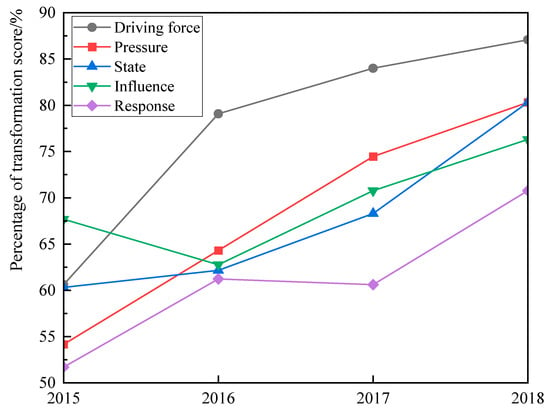
Figure 7.
Percentage of subsystem scores in economic structure transformation of coal energy-based cities.
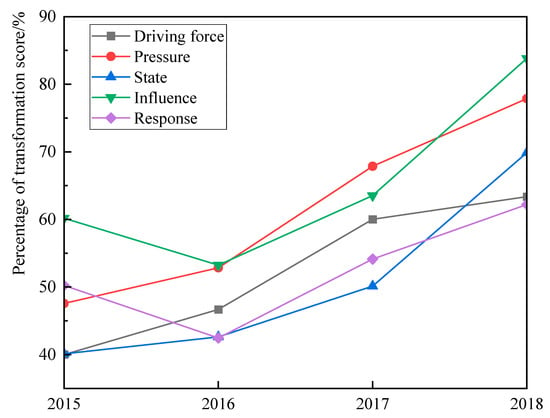
Figure 8.
Scoring percentage of subsystems in social and economic transformation of coal-based energy cities.
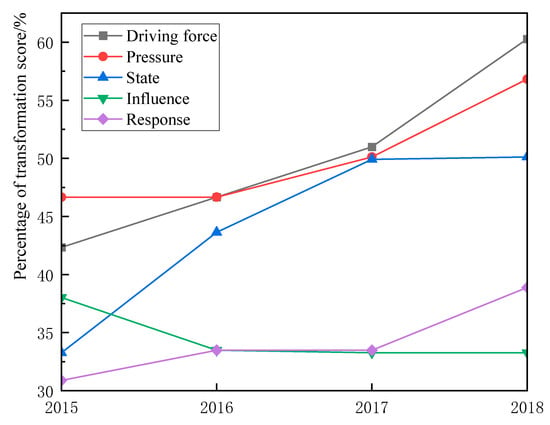
Figure 9.
Percentage of subsystem scores for urban construction transformation of coal-energy cities.
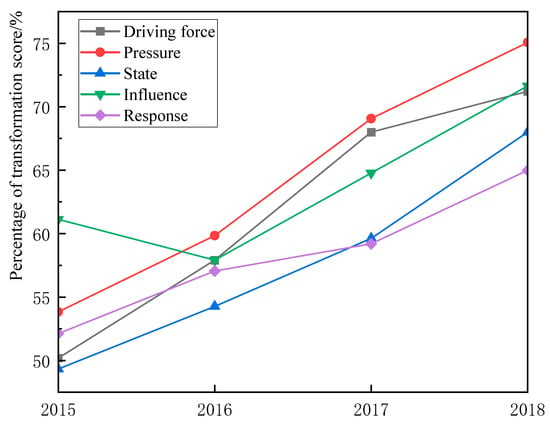
Figure 10.
Scoring percentage of subsystems in comprehensive economic transformation of coal-based energy cities.
Economic transformation: according to the calculation results of the economic transformation evaluation model of coal energy-based cities, in the economic structure level, the transformation scores of each subsystem of a city showed an overall upward trend from 2015 to 2018, the transformation scores of driving forces increased from 0.606 to 0.871, and the transformation scores of pressures increased from 0.542 to 0.803 (as shown in Figure 7). This shows that in the practice of transformation, the driving force and pressure factors are in a good position, and the driving force for the economic development of coal-energy cities is sufficient. Rising driver scores indicate increased investment, contributing to the gradual economic and environmental transformation of coal cities.
Social and economic transformation: according to the calculation results of the economic transformation evaluation model of coal energy-based cities, in the socio-economic structure level, the transformation scores of each subsystem of a city showed an overall upward trend from 2015 to 2018, the transformation scores of the pressure system increased from 0.476 to 0.779, and the transformation scores of the state system increased from 0.401 to 0.699 (as shown in Figure 8). This shows that in the practice of transformation, the pressure and state factors are in a higher position, and the pressure of social and economic transformation of coal-energy cities is greater. In the process of economic transformation, the pressure score rises fast and will lead to a rapid shift in the energy mix.
Urban construction transformation: according to the calculation results of the economic transformation evaluation model of coal energy-based cities, in the urban construction structure level, the transformation score of each subsystem of a city showed an overall upward trend from 2015 to 2018, the transformation score of the driving force system increased from 0.423 to 0.603, and the transformation score of the pressure system increased from 0.467 to 0.568 (as shown in Figure 9). This shows that in the process of transformation, the driving forces and pressure factors are in a high position, and infrastructure construction should be strengthened in the process of transformation. The infrastructure construction drive scores a rapid rise, giving ample impetus to the transformation of coal cities.
Comprehensive transformation of urban economy: according to the calculation results of the economic transformation evaluation model of coal energy-based cities, at the level of comprehensive transformation structure, the transformation score of each subsystem of a city showed an overall upward trend from 2015 to 2018, the transformation score of the pressure system increased from 0.538 to 0.751, and the transformation score of the impact system increased from 0.611 to 0.716 (as shown in Figure 10). This shows that in the practice of transformation, the comprehensive economic transformation of coal-based energy cities is affected by environmental factors. In addition, the improvement of the environment has, to some extent, contributed to the transformation of the integrated economy.
5. Conclusions
At present, various contradictions in most coal-energy cities have become increasingly prominent, which has become a disharmonious factor restricting the optimization and upgrading of coal-energy cities. Taking effective improvement and protection measures to promote the economic transformation of coal energy-resource-based cities to ensure the sustainable development of cities is an important strategic goal and the main task of departments at all levels since the new century. To solve the above problems, this paper evaluates coal energy efficiency by using the DEA method and designs an optimized and improved TOPSIS economic transformation evaluation model based on the entropy weight method to conduct an in-depth theoretical study on the economic transformation and sustainable development path of coal-energy cities.
The primary goal of this paper’s research is to examine how cities that rely on coal for energy are evolving economically and developing sustainably. We have mainly done the following in this work:
- (1)
- This paper first analyzes the industrial development process of coal energy-resource-based cities, which manifests itself in the depletion of resources and the beginning of losses for coal enterprises. Then, the industrial efficiency of coal energy is evaluated based on the DEA method, which has the advantage of facilitating the evaluation of the relative efficiency of energy units. On this basis, the development strategy of the industrial economy of coal-energy cities is proposed, involving energy structure adjustment, industrial upgrading, and other programs.
- (2)
- This paper summarizes the industrial transformation process of coal-energy cities, including the three aspects of environmental assessment, development orientation and model selection. Then, the evaluation method of industrial and economic transformation of coal-energy cities—namely, the AHP hierarchical analysis method—is designed.
- (3)
- In this paper, a set of evaluation index systems suitable for the economic transformation of coal-based energy cities is determined, and an improved TOPSIS coal-based energy city economic transformation evaluation model based on entropy weight is constructed. Finally, based on the transformation evaluation model and sustainable development theory, the industrial economic statistics of a city over the years are calculated and analyzed. It is found that in the economic structure level, the transformation score of the driving force is increased from 0.606 to 0.871; in the level of social economic structure, the transition score of the pressure system increased from 0.476 to 0.779, and the transition score of the state system increased from 0.401 to 0.699; the TOPSIS model mainly uses the entropy value of indicators to determine the weight of indicators according to the size of the information of each indicator, and obtains objective evaluation results, thus making the determined weights more scientific.
The calculation results of the economic transformation evaluation model of coal-based energy cities show that, in the practice of transformation, the driving force of the industrial economic development of coal-based energy cities is sufficient, while the pressure of social and economic transformation is great, so we should strengthen infrastructure construction in the process of transformation, and pay attention to protecting the urban environment. The evaluation model in this paper does not focus on the nonlinear correlation between Ci and Di, which may have some errors in the calculation and is a direction for future research.
Author Contributions
Conceptualization, H.H. and C.S.; methodology, C.S.; validation, H.H. and C.S.; formal analysis, H.H.; investigation, C.S.; resources, H.H.; data curation, C.S.; writing—original draft preparation, H.H.; writing—review and editing, C.S.; project administration, C.S.; funding acquisition, H.H. All authors have read and agreed to the published version of the manuscript.
Funding
This research was funded by the National Natural Science Foundation of China (Grant Number 41701613) and the Fundamental Research Funds for the Central Universities (Grant Number B220207024).
Data Availability Statement
The experimental data used to support the findings of this study are available from the corresponding author upon request.
Conflicts of Interest
The authors declare no conflict of interest.
References
- Hadi-Vencheh, A.; Wanke, P.; Jamshidi, A. What does cost structure have to say about thermal plant energy efficiency? The case from Angola. Energies 2020, 13, 2404. [Google Scholar] [CrossRef]
- Wu, G.; Hu, Y.; Kong, P. Using a network DEA model to assess the energy efficiency of regions in China. IOP Conf. Ser. Earth Environ. Sci. 2020, 546, 022054. [Google Scholar] [CrossRef]
- Xu, T.; You, J.; Li, H.; Shao, L. Energy efficiency evaluation based on data envelopment analysis: A literature review. Energies 2020, 13, 3548. [Google Scholar] [CrossRef]
- Niu, L.; Pan, M.; Zhou, Y. Evaluation method for urban renewable energy utilisation efficiency based on DEA model. Int. J. Glob. Energy Issues 2020, 42, 127–143. [Google Scholar] [CrossRef]
- Lin, X.; Zhu, X.; Han, Y.; Geng, Z.; Liu, L. Economy and carbon dioxide emissions effects of energy structures in the world: Evidence based on SBM-DEA model. Sci. Total Environ. 2020, 729, 138947. [Google Scholar] [CrossRef]
- Wang, Q.S.; Su, C.W.; Hua, Y.F.; Umar, M. Can fiscal decentralisation regulate the impact of industrial structure on energy efficiency? Econ. Res. Ekon. Istraživanja 2021, 34, 1727–1751. [Google Scholar] [CrossRef]
- Xu, Y.; Zhao, Y.; Li, X.; Yu, H.; Li, J.; Zou, G.; Zhao, J. Construction and demonstration of urban resource and environment performance indicator system in Central Plains Economic Zone. Environ. Sci. Res. 2016, 29, 925–935. [Google Scholar] [CrossRef]
- Blagojević, A.; Vesković, S.; Kasalica, S.; Gojić, A.; Allamani, A. The application of the fuzzy AHP and DEA for measuring the efficiency of freight transport railway undertakings. Oper. Res. Eng. Sci. Theory Appl. 2020, 3, 1–23. [Google Scholar] [CrossRef]
- Hassanpour, M. Evaluation of Iranian small and medium-sized industries using the DEA based on additive ratio model–a review. Facta Univ. Ser. Mech. Eng. 2020, 18, 491–511. [Google Scholar] [CrossRef]
- Stević, Ž.; Miškić, S.; Vojinović, D.; Huskanović, E.; Stanković, M.; Pamučar, D. Development of a Model for Evaluating the Efficiency of Transport Companies: PCA–DEA–MCDM Model. Axioms 2022, 11, 140. [Google Scholar] [CrossRef]
- Wang, L.; Song, X.; Song, X. Research on the measurement and spatial-temporal difference analysis of energy efficiency in China’s construction industry based on a game cross-efficiency model. J. Clean. Prod. 2021, 278, 123918. [Google Scholar] [CrossRef]
- Mohsin, M.; Hanif, I.; Taghizadeh-Hesary, F.; Abbas, Q.; Iqbal, W. Nexus between energy efficiency and electricity reforms: A DEA-based way forward for clean power development. Energy Policy 2021, 149, 112052. [Google Scholar] [CrossRef]
- Wang, X.; Hou, R.; Wang, L. Research on evaluation system of low-carbon transformation of resource-based cities based on TOPSIS method—Taking Jiaozuo City as an example. Ecol. Econ. 2015, 31, 42–46. [Google Scholar] [CrossRef]
- Cong, D.; Liang, L.; Jing, S.; Han, Y.; Geng, Z.; Chu, C. Energy supply efficiency evaluation of integrated energy systems using novel SBM-DEA integrating Monte Carlo. Energy 2021, 231, 120834. [Google Scholar] [CrossRef]
- Inglesi-Lotz, R. The impact of renewable energy consumption to economic growth: A panel data application. Energy Econ. 2016, 53, 58–63. [Google Scholar] [CrossRef]
- Turnheim, B.; Geels, F.W. Regime destabilisation as the flipside of energy transitions: Lessons from the history of the British coal industry (1913–1997). Energy Policy 2012, 50, 35–49. [Google Scholar] [CrossRef]
- Fremouw, M.; Bagaini, A.; De Pascali, P. Energy Potential Mapping: Open Data in Support of Urban Transition Planning. Energies 2020, 13, 1264. [Google Scholar] [CrossRef]
- Lewandowska, A.; Chodkowska-Miszczuk, J.; Rogatka, K.; Starczewski, T. Smart energy in a smart city: Utopia or reality? evidence from Poland. Energies 2020, 13, 5795. [Google Scholar] [CrossRef]
- Urrutia-Azcona, K.; Usobiaga-Ferrer, E.; De Agustín-Camacho, P.; Molina-Costa, P.; Benedito-Bordonau, M.; Flores-Abascal, I. ENER-BI: Integrating energy and spatial data for cities’ decarbonisation planning. Sustainability 2021, 13, 383. [Google Scholar] [CrossRef]
- Haseeb, M.; Hassan, S.; Azam, M. Rural–urban transformation, energy consumption, economic growth, and CO2 emissions using STRIPAT model for BRICS countries. Environ. Prog. Sustain. Energy 2017, 36, 523–531. [Google Scholar] [CrossRef]
- Becchio, C.; Ferrando, D.G.; Fregonara, E.; Milani, N.; Quercia, C.; Serra, V. The cost-optimal methodology for the energy retrofit of an ex-industrial building located in Northern Italy. Energy Build. 2016, 127, 590–602. [Google Scholar] [CrossRef]
- Xiang, Z.; Liu, X. Coal-based transformation of cities in Shandong Province, China. Chin. J. Popul. Resour. Environ. 2015, 13, 358–364. [Google Scholar] [CrossRef]
- Gonzalez-Salazar, M.; Langrock, T.; Koch, C.; Spieß, J.; Noack, A.; Witt, M.; Ritzau, M.; Michels, A. Evaluation of energy transition pathways to phase out coal for district heating in Berlin. Energies 2020, 13, 6394. [Google Scholar] [CrossRef]
- Zhao, Y. Analysis on the Economic Transformation Path of Resource based Cities in the New Era—Analysis based on the “Progressive Association” Support Mechanism. Chang. Acad. J. 2020, 1, 103–111. [Google Scholar] [CrossRef]
- Zheng, H.; Ge, L. Research on the impact of sustainable development of resource-based cities on carbon emissions—Based on the perspective of resource dependence. China Environ. Sci. 2022, 42, 2955–2964. [Google Scholar] [CrossRef]
- Zhang, B.; Wang, J.; Lü, L.; Xia, J.; Yang, Z.; Luo, H. Thinking on energy transformation of resource-based cities—Taking Taiyuan as an example. J. Environ. Eng. Technol. 2021, 11, 181–186. [Google Scholar] [CrossRef]
Disclaimer/Publisher’s Note: The statements, opinions and data contained in all publications are solely those of the individual author(s) and contributor(s) and not of MDPI and/or the editor(s). MDPI and/or the editor(s) disclaim responsibility for any injury to people or property resulting from any ideas, methods, instructions or products referred to in the content. |
© 2023 by the authors. Licensee MDPI, Basel, Switzerland. This article is an open access article distributed under the terms and conditions of the Creative Commons Attribution (CC BY) license (https://creativecommons.org/licenses/by/4.0/).